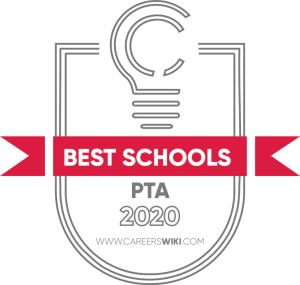…
There are seven physical therapy assistant schools in Iowa that offer nationally accredited programs.
They are widely scattered across the state. Six of the schools are public community colleges, and one is a private institution at a major hospital. Full-time students graduate in two years or sooner. Their diplomas enable them to take a national examination and apply for licenses.
The demand for PTAs in the Hawkeye State is accelerating. The occupation ranks among Iowa’s fastest-growing fields. Government labor officials have estimated that about 140 jobs will become available each year through the 2016-26 decade.
You Might Also Like:

Operating under the Bureau of Professional Licensure in the state Department of Public Health, this board is charged with protecting public safety by regulating physical therapy.
The board drafts rules related to education and other requirements for prospective PTAs seeking to practice in Iowa, granting licenses to those who comply. The officials initiate investigations of PTAs accused of illegal or improper behavior, assessing penalties when justified.
The state governor names seven board members, whom the Senate confirms. There are three PTs, two occupational therapists, and two residents who represent the general public.
To become a physical therapy assistant in Iowa, it is imperative to begin by completing either a high school education or the GED process. Some experts recommend multiple high school classes in science and health subjects.
Those planning to work in Iowa must successfully complete a postsecondary PTA program at a nationally accredited school. The Board of Physical & Occupational Therapy does not specify an accrediting organization, but students should be aware that in most states it is necessary to enroll in a program that the Commission on Accreditation in Physical Therapy Education (CAPTE) has approved.
Every other year, practicing PTAs need to show proof of having received 20 continuing education hours — with at least 15 hours concerning the clinical application of physical therapy.
The board mandates that all practitioners hold licenses. The steps to licensure include undergoing a criminal background check, asking a PTA school submit a graduate’s transcripts, and taking the National Physical Therapy Examination (NPTE).
The Federation of State Boards of Physical Therapy collects a fee of approximately $400 from an applicant whom it deems eligible to take the NPTE. The organization provides a candidate handbook to help students prepare.
Questions on the computerized test concern PT interventions, diseases and conditions that affect treatment, the collection of PT data, therapeutic techniques, devices and equipment, safety and protection, professional responsibilities, and research.
The exam is periodically available at Prometric centers in Des Moines, Bettendorf, Coralville, and Sioux City. A passing score is 600 or higher on a scale of 200-800.
Licensed PTA have to apply to the board for renewed licenses every second year.
We selected the schools below based on the programs that they offer, accreditation, student population, graduation rate and reputation.
View our Ranking Methodology to learn more about how we rank schools.

42%
727
This Des Moines institution boasts a 9:1 student-to-teacher ratio and the lowest tuition among the state’s private schools.
The 77-credit PTA program lasts five semesters. Along with the courses found at all schools, students take General and Developmental Psychology, Professional Issues, Issues in Clinical Practice, and Small Group Communication. They perform four clinical rotations at Mercy Hospital or other sites.
The program reports 100 percent rates for passing the licensure exam and finding a job within six months. A graduate may pursue a bachelor of science in healthcare administration or health sciences.
33%
3918
With three southern Iowa locations, IHCC awards degrees to PTA graduates on the main campus in Ottumwa.
The 82-credit program consists of seven terms in 21 months. Among the core courses are Computer Essentials, PTA Trends, Composition I and II, Public Speaking, Pharmaceutical Applications, Health Society and Aging, two psychology classes, two communication classes, a mathematical reasoning course, and a humanities elective.
Following acceptance, program applicants must complete 40 hours of observation at clinical sites. All graduates in recent years have passed the licensing exam and become employed in the field.
22%
5962
This institution’s main campus in Council Bluffs hosts a program for future PTAs who live in southwest Iowa and eastern Nebraska.
The curriculum takes two years to complete, with the typical courses plus Classical Physics I and II and Technical Physics. Students get practical experience during four clinical assignments in a range of clinical settings.
Before beginning the technical coursework, it is necessary to take general education classes in biological, physical, physiological, and anatomical principles. There are no pre-admission placement testing requirements.
46%
2995
NIACC, which has been ranked among the top 100 community colleges in the country, offers a two-year program.
The 71-semester-hour curriculum on the Mason City campus features the usual courses plus Composition I and II, PTA Career Essentials, and two psychology classes. Students spend 17 weeks working in clinics.
Program applicants must meet two of the three following criteria: graduating in the top half of a high school class, a 3.00 high school GPA, or an ACT composite score of 20. Another entrance requirement is 12 hours of observation in a physical therapy setting.
32%
5263
Located in Waterloo, this school provides a program with 74 credits.
Students begin by attending these general education classes: Introduction to Computers, Composition I, Introduction to Psychology or Sociology, Fundamentals of Oral Communication, Math for Liberal Arts, and Developmental Psychology. Placement tests determine the need for additional math, English, or reading courses.
The school’s Patient Simulator Laboratory has full-body manikins and other equipment that replicate hospital settings. Four clinical rotations at off-campus sites total 640 clock hours. Program applicants need 24 hours of clinical observation experience in three locations.
36%
5674
PTA students here, in Sioux City, take five semesters to finish 73 credits.
The curriculum involves the standard subject matter, with extra courses called Activities of Daily Living, Healthcare Intervention, Pharmacology for the PTA, Composition I, College Algebra, Introduction to Sociology, Introduction to Psychology, Career Essentials for the PTA, and Developmental Psychology. Three clinical affiliations take place during the final semester.
For admission, a student needs one of the following: a composite ACT score of 22; a 22 on the Math ACT; a 30 ALEKS score; an associate or higher degree; or acceptable grades on anatomy, physiology, and algebra tests.
29%
13906
Based in Cedar Rapids, KCC delivers its PTA program at the Linn County Regional Center in Hiawatha.
Students take part in 73 credit hours of coursework for two years. Prerequisite classes are Introduction to PTA, Anatomy and Physiology I, and either a communication or public speaking course. Among the technical classes are Functional Development, Professionals in Health, Introduction to Psychology, Composition I, PTA Career Essentials, and a humanities or history/culture course.
There are four short-term and two long-term clinical experiences across Iowa and in neighboring states. The school touts its “spacious lab with state-of-the-art equipment.”
All the schools on our list are recognized by the Commission on Accreditation in Physical Therapy Education. They award Associate of Applied Science (AAS) degrees to students who complete between 71 and 82 credit hours of instruction and training.
Curricula involve theory and practice, with lectures in classrooms, hands-on applications in labs, and real-world experiences in PT facilities. Standard courses cover human anatomy, human physiology, pathophysiology, medical terminology, kinesiology, PT modalities, therapeutic techniques, and musculoskeletal neurological rehabilitation.
Income-eligible community college students may apply for the Iowa Skilled Workforce Shortage Tuition Grant, also known as the Kibbie Grant, which pays half of tuition fees.
$23.35
$48,600
30%
An Iowa PTA in the median salary range makes more than $48,600 a year or about $23.35 per hour—not as good as the country’s averages of over $58,000 or nearly $28.
However, those with incomes in the lowest tenth do better than their peers nationwide—almost $36,600 or approximately $17.60, compared to around $33,800 or $16.25. Practitioners among the highest tenth rake in close to $67,600 or about $32.50—short of the U.S. rates of over $79,800 or $38.35.
After reporting 870 licensed PTAs in 2016, Iowa was expected to hike the number to 1,130 by the end of the ensuing decade. Such an escalation would be a 30 percent jump, about the same as the 31 percent projected nationwide.
Sources: U.S. Bureau of Labor Statistics, CareerOneStop

LIMITED TIME DEAL